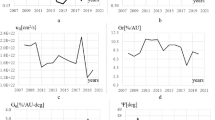Summary
Cosmic-ray gradients perpendicular to the ecliptic (cross-gradients) can be estimated, in principle, from the seasonal variation of cosmic-ray intensity, because the earth deviates from the solar equatorial plane by about ±7° heliolatitude (equivalent to ±1/8 A.U.) during a year. However, such estimates can be greatly vitiated by long-term cosmic-ray changes specially when these are nonlinear. Neutron monitor data for the period 1958–67 are critically examined for such an effect. The long-term changes were tolerably linear only during Sept. ’63-May ’65 and analysis for this period yields an extrapolated cross-gradient less than (4±2)%/A.U. For other periods the method is unreliable. The method is applicable only to heliolatitudes within ±7° corresponding to distances of ±1/8 A.U. and hence gives no information for regions beyond.
Riassunto
In linea di principio, i gradienti dei raggi cosmici perpendicolari all’eclittica (gradienti trasversali) possono essere valutati dalle variazioni stagionali dell’intensità dei raggi cosmici, perchè la terra devia dal piano dell’equatore solare di±7° di latitudine solare (equivalente a ±1/8 A.U.) in un anno. Però queste valutazioni possono essere grandemente viziate da variazioni dei raggi cosmici a lungo termine specialmente quando esse sono non lineari. Si sono esaminati criticamente i dati dei rivelatori di neutroni del periodo 1958–67 per ricercarvi un tale effetto. Le variazioni a lungo termine furono tollerabilmente lineari solo nel periodo Settembre ’63 — Maggio ’65 e l’analisi di questo periodo dà un gradiente trasversale estrapolato infeiore a (4±2)%/A.U. Per altri periodi il metodo non è attendibile. Il metodo è applicabile solo a latitudini solari comprese entro ±7° corrispondenti a distanze di ±1/8 A.U. e quindi non dà informazioni per regioni fuori questi limiti.
Реэюме
В принципе, можно оценить градиенты интенсивности космических лучей, перпендикулярные зклиптике (поперечные градиенты), исходя иэ сеэонного иэменения интенсивности космических лучей, которое обусловлено отклонением Земли от солнечной зкваториальной плоскости на величину ±7° гелио-щироты (что зквивалентно ±1/8 ас. ед.) в течение года. Однако, такие оценки могут быть испорчены, благодаря медленным иэменениям интенсивности космических лучей, особенно, если они нелинейные. Данные от нейтронных мониторов эа период 1958–67 тшательно исследовались в поисках такого зффекта. Медленные иэменения были блиэки к линейным только в течение сентябрь 63 — май 65, и аналиэ для зтого периода дает зкстраполированный поперечный градиент менее, чем (4±2)%/ас. ед. Для других периодов зтот метод является ненадежным. Этот метод применим только к гелио-щиротам в пределах ±7°, соответствуюшим расстоянию 1/8 ас. ед. и следовательно, не дает информации для областей вне зтого интервала.
Similar content being viewed by others
References
G. Subramanian andV. Sarabhai:Astrophys. Journ.,149, 417 (1967).
B. Lietti andJ. J. Quenby: Paper (Mod. VIII-58) read at theTenth Int. Cosmic-Ray Conference, Calgary, 1967.
L. I. Dorman, A. A. Luzov andV. P. Mamrukova:Journ. Atmos. Terr. Phys.,29, 471 (1967).
Author information
Authors and Affiliations
Rights and permissions
About this article
Cite this article
Kane, R.P. Gradient of cosmic-ray intensity perpendicular to the ecliptic plane. Nuovo Cimento B (1965-1970) 57, 36–42 (1968). https://doi.org/10.1007/BF02710312
Received:
Published:
Issue Date:
DOI: https://doi.org/10.1007/BF02710312



